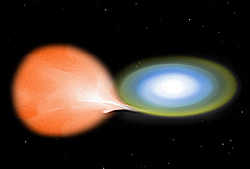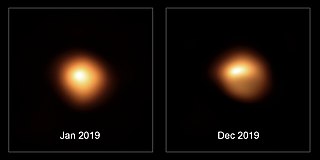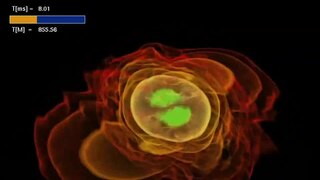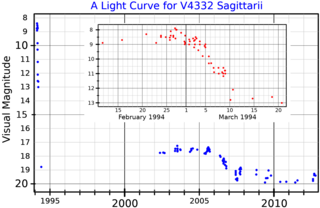
A nova is a transient astronomical event that causes the sudden appearance of a bright, apparently "new" star that slowly fades over weeks or months. Causes of the dramatic appearance of a nova vary, depending on the circumstances of the two progenitor stars. All observed novae involve white dwarfs in close binary systems. The main sub-classes of novae are classical novae, recurrent novae (RNe), and dwarf novae. They are all considered to be cataclysmic variable stars.

A supernova is a powerful and luminous explosion of a star. A supernova occurs during the last evolutionary stages of a massive star or when a white dwarf is triggered into runaway nuclear fusion. The original object, called the progenitor, either collapses to a neutron star or black hole, or is completely destroyed to form a diffuse nebula. The peak optical luminosity of a supernova can be comparable to that of an entire galaxy before fading over several weeks or months.

A variable star is a star whose brightness as seen from Earth changes with time. This variation may be caused by a change in emitted light or by something partly blocking the light, so variable stars are classified as either:

In astronomy, a contact binary is a binary star system whose component stars are so close that they touch each other or have merged to share their gaseous envelopes. A binary system whose stars share an envelope may also be called an overcontact binary. The term "contact binary" was introduced by astronomer Gerard Kuiper in 1941. Almost all known contact binary systems are eclipsing binaries; eclipsing contact binaries are known as W Ursae Majoris variables, after their type star, W Ursae Majoris.

V838 Monocerotis is a spectroscopic binary star system in the constellation Monoceros about 19,000 light years from the Sun. The previously unremarked star was observed in early 2002 experiencing a major outburst, and was one of the largest known stars for a short period following the outburst. Originally believed to be a typical nova eruption, it was then identified as the first of a new class of eruptive variables known as luminous red novae. The reason for the outburst is still uncertain, but is thought to have been a merger of two stars within a triple system.

The Pinwheel Galaxy is a face-on spiral galaxy 21 million light-years away from Earth in the constellation Ursa Major. It was discovered by Pierre Méchain in 1781 and was communicated that year to Charles Messier, who verified its position for inclusion in the Messier Catalogue as one of its final entries.

NGC 300 (also known as Caldwell 70) is a spiral galaxy in the constellation Sculptor. It is one of the closest galaxies to the Local Group, and probably lies between the latter and the Sculptor Group. It is the brightest of the five main spirals in the direction of the Sculptor Group. It is inclined at an angle of 42° when viewed from Earth and shares many characteristics of the Triangulum Galaxy. It is 94,000 light-years in diameter, somewhat smaller than the Milky Way, and has an estimated mass of (2.9 ± 0.2) × 1010M☉.

Chromium(II) oxide (CrO) is an inorganic compound composed of chromium and oxygen. It is a black powder that crystallises in the rock salt structure. Hypophosphites may reduce chromium(III) oxide to chromium(II) oxide:

A Type Ia supernova is a type of supernova that occurs in binary systems in which one of the stars is a white dwarf. The other star can be anything from a giant star to an even smaller white dwarf.

Shrinivas Ramchandra Kulkarni is a US-based astronomer born and raised in India. He is currently a professor of astronomy and planetary science at California Institute of Technology, and he served as director of Caltech Optical Observatory (COO) at California Institute of Technology, in which capacity he oversaw the Palomar and Keck among other telescopes. He is the recipient of a number of awards and honours.

The known history of supernova observation goes back to 1006 AD. All earlier proposals for supernova observations are speculations with many alternatives.

In astronomy, a common envelope (CE) is gas that contains a binary star system. The gas does not rotate at the same rate as the embedded binary system. A system with such a configuration is said to be in a common envelope phase or undergoing common envelope evolution.

A stellar collision is the coming together of two stars caused by stellar dynamics within a star cluster, or by the orbital decay of a binary star due to stellar mass loss or gravitational radiation, or by other mechanisms not yet well understood.
In astronomy, a calcium-rich supernova is a subclass of supernovae that, in contrast to more well-known traditional supernova classes, are fainter and produce unusually large amounts of calcium. Since their luminosity is located in a gap between that of novae and other supernovae, they are also referred to as "gap" transients. Only around 15 events have been classified as a calcium-rich supernova – a combination of their intrinsic rarity and low luminosity make new discoveries and their subsequent study difficult. This makes calcium-rich supernovae one of the most mysterious supernova subclasses currently known.

ASASSN-15lh is an extremely luminous astronomical transient event discovered by the All Sky Automated Survey for SuperNovae (ASAS-SN), with the appearance of a superluminous supernova event. It was first detected on June 14, 2015, located within a faint galaxy in the southern constellation Indus, and was the most luminous supernova-like object ever observed. At its peak, ASASSN-15lh was 570 billion times brighter than the Sun, and 20 times brighter than the combined light emitted by the Milky Way Galaxy. The emitted energy was exceeded by PS1-10adi.

M31-RV is a possible red cataclysmic variable star located in the Andromeda Galaxy (M31) that experienced an outburst in 1988, which is similar to the outburst V838 Monocerotis experienced in 2002. Such objects have been called luminous red novae or intermediate-luminosity red transients. During the outburst, both V838 Mon and M31-RV reached a maximum absolute visual magnitude of -9.8.

KIC 9832227 is a contact binary star system in the constellation Cygnus, located about 2,060 light-years away. It is also identified as an eclipsing binary with an orbital period of almost 11 hours.
V1309 Scorpii is a contact binary that merged into a single star in 2008 in a process known as a luminous red nova. It was the first star to provide conclusive evidence that contact binary systems end their evolution in a stellar merger. Its similarities to V838 Monocerotis and V4332 Sagittarii allowed scientists to identify these stars as merged contact binaries as well.

M101 OT2015-1 is a contact binary that merged into a single star, in a process known as a luminous red nova (LRN). M101 OT2015-1 is an optical transient located in the Pinwheel Galaxy (M101). Luminous red novae are representatives of the sparsely populated class of exploding variables which is known since 1988 when such a star (M31-RV) appeared in the M31 galaxy.

V4332 Sagittarii is a nova-like event in the constellation of Sagittarius. It was discovered February 24, 1994 at an apparent visual magnitude of 8.9 by Japanese amateur astronomer Minoru Yamamoto from Okazaki, Aichi, then confirmed by K. Hirosawa. Initially designated Nova Sagittarii 1994 #1, it was given the variable star designation V4332 Sgr. A spectra of the event taken March 4 lacked the characteristic features of a classical nova, with the only emission lines being of the Balmer series. Subsequent spectra showed a rapid decline in luminosity and a change of spectral type over a period of five days. By 2003, the object was ~1500 times less luminous than at peak magnitude and showed a spectrum of an M-type star.


















